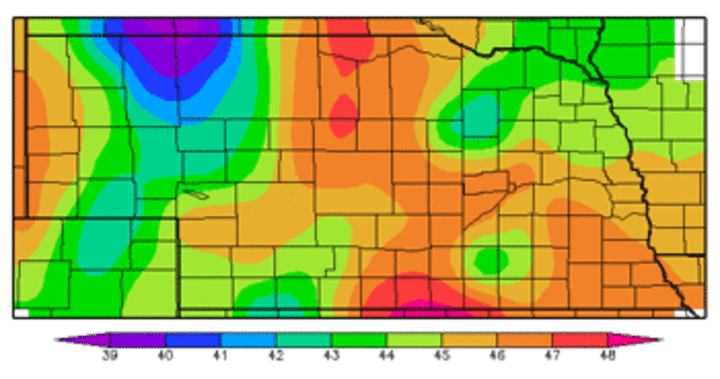April 17, 2009
This spring has been a challenge for Nebraska crop producers to accomplish any field work, leading some to ask: "How important is it to plant corn early?"Research shows a small yield loss with very early corn planting dates and a larger yield loss with late planting dates.
Roger Elmore and Lori Abendroth, former UNL extension agronomists who are now at Iowa State University, write:
"We believe that corn can be planted prior to April 20 and reach its maximum yield potential in all parts of the state. This should provide a sense of security to producers who need to plant earlier than in the past to get all their corn acres planted. Demographically, producers in southern counties can begin planting about two weeks before northern counties. Of course, embedded within this planting date recommendation is the assumption that soil conditions are favorable and that good hybrids have been selected. Planting date is simply one criterion among many that will help a producer reach maximum yield potential."

Seedbed condition is important for seed germination and plant establishment even though the calendar says it is time to plant corn. The growing point on corn is below ground until the sixth leaf so the plant is able to sustain cold temperatures with minimal long-term freeze damage.
Corn Planting Research from Iowa State University
Iowa State University has conducted several studies on how corn planting date affects yield.
Three years of planting date research (1998-2000) at Lewis, Ames, and Nashua were summarized. Planting between April 20 and May 5 resulted in 100% yield potential, although a 99% yield potential could still be achieved with a planting date up to May 20. A significant yield reduction occurred only once when the planting date was extended to late May or June.
| Table 1. ISU Southeast Research and Demonstration Farm (Crawfordsville) planting date research conducted by K. Van Dee and J. Jensen. Yield response to planting date averaged across 2002 to 2004. | |
| Planting Date (+/-3 days) |
Yield (bu/acre)* |
| March 15 |
208 a |
| April 1 | 210 a |
| April 15 | 205 a |
| May 1 | 183 b |
|
*Yield values with any letter in common are not significantly different from one another. |
|
| Table 2. ISU Northeast Research and Demonstration Farm (Nashua) planting date research conducted by K. Pecinovsky. Yield response to planting date averaged across 2003 to 2005. | |
| Planting Date Window | Yield (bu/acre)* |
| March 20-April 5 | 186 b |
| April 5-April 20 | 198 a |
| April 20-May 5 | 196 a |
| May 5-May 20 | 183 b |
| *Yield values with any letter in common are not significantly different from one another. | |
An earlier planting window was used in more recent research, with dates beginning as early as March. This research was featured in the article "Polymer Coatings for Early Planted Corn" on the ISU Corn Production Web site. The following results are the average of polymer coated and non-coated seed within each planting date. At Crawfordsville, four planting dates were used (Table 1). Corn planted between March 15 and April 15 yielded similarly. A significant yield loss did not occur until corn was planted on May 1 (183 bu/ac). Data from the Nashua location show the optimum planting window shifted a bit later (Table 2). The highest yields were achieved with planting between April 5 and May 5. A planting date that was too early (between March 20 and April 5) or too late (between May 5 and May 20) yielded significantly less.
Overall, past and present research has shown a small yield loss with very early planting dates and a larger yield loss with late planting dates. This late planting yield loss is again confirmed by research at Nashua, Crawfordsville, and 2006 data (not shown). Although a yield loss is still possible if corn is planted too early, the optimum planting window may be earlier than previously thought.
To understand the overall response to planting date requires several years of research to eliminate year to year variability. Environmental conditions can easily reduce yield of corn planted one year and not the next, dependent on when stresses occur in the plant's development. Therefore, 2006 results are not shown here in detail as more years need to be accumulated first. In general, the 2006 date showed a positive yield response to early planting dates with yields dropping off past mid-May; the optimum window was generally between April 15 and May 10.
Recommended Nebraska Corn Planting Dates
Optimum planting dates for corn on average are between April 25 and May 10 in southeastern and south central Nebraska and between May 5 and May 20 in northern Nebraska. On average the optimum planting period is May 1 to May 15.
The difference in yield response to planting dates may relate directly to weather. Heat and/or moisture stress around pollination can greatly affect yields. A cold spell in spring can delay early planting one year while the next year it may not be a factor.
Bob Klein
Extension Western Nebraska Crops Specialist
Protecting Your Future Earlier this spring the National Corn Growers Association issued a release reminding growers to develop an Insect Resistance Management Plan (IRM) and follow refuge requirements to prevent or delay the development of insect resistance to new technologies."Future traits that build on today's technology will only be successful if today's technology remains effective," said Rob Korff, chair of the Biotechnology Working Group of the National Corn Growers Association. |
